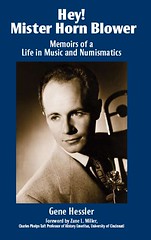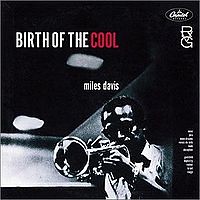
PREV ARTICLE
NEXT ARTICLE
FULL ISSUE
PREV FULL ISSUE
BOOK REVIEW: HEY! MISTER HORN BLOWER Dave Lange submitted this review of Gene Hessler's new memoir. Thanks! -Editor Hey! Mister Horn Blower: Memoirs of a Life in Music and Numismatics by Gene Hessler Gene Hessler is well known to numismatic bibliophiles as a top researcher of worldwide paper currency and other printed securities, particularly with reference to the artists and engravers who created these pieces. He’s written several books on the subject. Many people in the hobby also know that he was formerly a professional musician, though the details of his career were never fully explored until now. Gene has written his memoirs detailing the two careers that have occupied his lifetime, and this was a book I was quite looking forward to reading. Gene Hessler is well known to numismatic bibliophiles as a top researcher of worldwide paper currency and other printed securities, particularly with reference to the artists and engravers who created these pieces. He’s written several books on the subject. Many people in the hobby also know that he was formerly a professional musician, though the details of his career were never fully explored until now. Gene has written his memoirs detailing the two careers that have occupied his lifetime, and this was a book I was quite looking forward to reading.The book opens with a foreword by Zane L. Miller, Charles Phelps Taft Professor of History Emeritus, University of Cincinnati. Gene then tells of his childhood in a suburb of Cincinnati and his discovery of music. Beginning with the banjo, an instrument he later relates was the subject of much derision among fellow jazz musicians, he progressed to guitar and, ultimately, trombone. This became his primary tool of the trade in adulthood, seeing him through a career that began playing popular tunes for local dances. As he realized that other vocations were less appealing than the life of a full time musician, Gene formalized his studies in the field, culminating in his receiving a Masters degree in the 1950s. Along the way, he played with numerous bands during the declining years of the popular big bands, learning to appreciate the new sounds of the be bop and free form period. Gene played with many famous figures in the jazz field, including Cannonball Adderly, Billy May, Woody Herman and Doc Severinsen. Other names are less familiar in the popular culture, but they will bring a smile to those in the know. Leaving Harlem’s Apollo Theater late one night following a performance with Buddy Rich, Gene was greeted by a professional lady who furnished him with the main title of his book in an encounter that ended unsuccessfully for her. Not content to be merely a jazz man, Gene worked in Broadway pit orchestras, symphonies, touring bands and other venues not usually associated with the jazz field. As a musician, his experiences were remarkably broad. I was surprised by just how freely he and his fellow professionals moved from one gig to another, filling in for each other on a moment’s notice in any capacity required. Gene developed a reputation as an excellent sight reader, a musician who could perform a piece he’d never seen before and do it satisfactorily on the first take. So many pro musicians sought to play whichever job seemed most appealing at any given time that this ability to either be or locate a substitute served him quite well and provided him with a very broad resume. Never a childhood collector of coins, Gene discovered this activity quite casually in the early 1960s. His interest in first coins and then paper money received a big boost in 1964 when he toured Africa as part of a band assembled by the U. S. State Department, which was seeking goodwill among the many newly-independent nations of that region. Through a fellow musician he learned of Lester Merkin, himself a former professional musician and by the late 1960s a prominent dealer in coins and notes. It was through Lester that he learned of an opening for curator of the Chase Manhattan Bank Money Museum. At that time beards were still associated with bohemians, and Gene’s whiskers nearly cost him the job, but he overcame this obstacle and was hired for the position. He managed to arrange his hours so as to continue working some nights as a musician in Broadway shows, as well as being a regular in the house orchestra at Radio City Music Hall, again calling on substitutes as needed. The Chase position ended shortly after the bank closed its museum in 1975, Gene staying long enough to conclude its affairs, leaving in 1977. During his time there he was called upon a number of times to appear on television shows regarding whatever numismatic story had made the mainstream media at the time. He also managed to stump the panel on “What’s My Line?” It’s likely that none of the celebrity panelists even knew the word "numismatist". The museum curatorship also provided a wonderful opportunity to perform research utilizing its collection, and this further prompted Gene to continue his research at the Smithsonian and the National Archives in Washington, DC. This work resulted in the series of books carrying his name, my favorite of which is The Engraver’s Line. Gene’s many experiences in the numismatic field brought him into contact with a wide range of familiar personalities, some of whom have passed, while others remain quite active. A few readers of The E-Sylum will find their names mentioned in this memoir. As the 1970s gave way to the ‘80s, Gene continued to work as a professional musician, but to a gradually lessening degree. By the end of the decade he had given up paid performances entirely, though he still enjoyed playing for personal satisfaction with fellow musicians who relished the opportunity to do as they pleased musically. Gene’s accomplishments in numismatics are well enough known to E-Sylum readers that they don’t need repeating here, but he remains active as a researcher and educator. Gene’s memoirs betray the disappointment felt by many jazz musicians that the art itself and the people who crafted it are not held in higher esteem by Americans. This very American music form strayed from the popular during the late 1940s and early 1950s, becoming a style appreciated more by the players than by the audiences, though there remained a small following of hipsters who understood what the musicians were doing. This is my observation, though it seems to echo what Gene expresses in his book. There’s no real bitterness in his writing, however, merely a reflection of what should be. He is clearly not a fan of the more popular music of recent decades, as the home-made aspect of it is anathema to someone who has studied music formally and has played all its most complex variations. I’d say that Hey! Mister Horn Blower is about 70% music and 30% numismatics, reflecting the relative roles these fields have played in Gene’s life. I enjoyed both aspects, the music stories more so as they were less familiar to me. As one who played trombone in school myself but never progressed beyond mediocrity, I was pleased to read about the experiences of a professional who reached the top of his form and made the most of it. This is a very easy read and a quite enjoyable one. I highly recommend it to readers of The E-Sylum. Gene’s book is available directly from him at $25 postpaid for softcover and $35 postpaid for the hardcover. I chose the latter, and they are in limited supply. Gene requests that buyers specify whether they desire an unsigned book, a simple signature or a personalization. Orders should be made payable to Gene Hessler and sent to him at POB 31144, Cincinnati, OH 45231.  I've been reading the book myself and can echo Dave's statements. It's an easy and enjoyable read. I too, was fascinated by Gene's experiences in the music world. What could be cooler than being present at the Birth of Cool? Gene played trombone arrangements with their composer that later became famous on the seminal 1957 album by Miles Davis, The Birth of the Cool. And where else can you read in the same book about adventures in such far away nooks and crannies as Mogadishu, Somalia and McKeesport, PA? Even his off hours are fascinating, including many visits to Birdland to hear the likes of Harry Belafonte, Charlie Parker and Charlie Mingus. Or hanging with friends who played in The Tonight Show band while the group was entertained by Groucho Marx? I've been privileged to have known Gene for many years, and I'm very glad he took the time to write this great book - I recommend it to everyone with even a passing interest in either music or numismatics. It includes a very thorough appendix listing all of Gene's published works on numismatics. -Editor Wayne Homren, Editor The Numismatic Bibliomania Society is a non-profit organization promoting numismatic literature. See our web site at coinbooks.org. To submit items for publication in The E-Sylum, write to the Editor at this address: whomren@gmail.com To subscribe go to: https://my.binhost.com/lists/listinfo/esylum All Rights Reserved. NBS Home Page Contact the NBS webmaster 
|